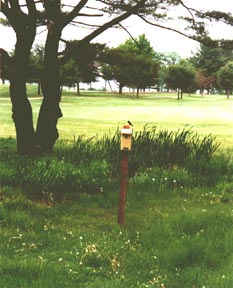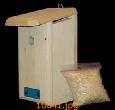Tree
Swallows
The Tree
Swallow (Trachycineta bicolor) is common in any wooded habitat near
lakes, streams or marshes. They nest in holes in dead trees, fence
posts, eaves, and nesting boxes. The slender Tree Swallow is
wonderful at aerial stunts, swooping and diving to catch flying
insects. Their reputation for catching mosquitoes far exceeds
reality, as they generally retire about the time of day when mosquitoes
are abundant.
Their dark
blue-green top and pure white underside distinguishes them. Males and
females look quite alike.
They spend
spring in all but the southernmost states and migrate to the Gulf coast
and Mexico for winter. Migrating flocks may number in the
thousands.
Tree
Swallows take readily to nesting boxes placed out in the open in rural or
suburban areas, and they are quite comfortable around people. Once
you have them nesting on your property, you may find their population
increasing if you put up more boxes each year, as they tend to return to
the same spots each year, especially if insects are abundant. Tree
swallows like to line their nests with grass and feathers. If you
have access to chicken feathers or others, leave some around the nesting
boxes, and the swallows will use them.
Prolonged
periods of cold, rainy weather will inhibit the Tree Swallows' ability to
catch insects, and the adults may travel a distance to find
some. Unfortunately, this sometimes leaves the young too long without
food, and they perish. But this will not keep them from returning to
start a new nesting. 
They lay 5
to 6 pure white eggs and generally raise one brood each year, which is
cared for by both parents.
Tree
Swallows feed on bayberries in the winter, allowing them to winter father
north than other swallows. They are also among the first to migrate north
in the spring.
Tree
Swallows like playing with feathers, and can frequently be seen tossing
one into the air and catching it, or chasing another swallow with a
feather.
Tree
Swallows will tolerate fairly close neighbors of their own
kind. Nesting boxes may be placed as close as 30 feet apart, or even
on the same tree. They should be mounted on posts or trees out in the
open, near water. It is even acceptable to place the post in
water.
Tree
Swallows are good neighbors for Eastern Bluebirds and will even help to
defend the less aggressive bluebird against its competitors. They
like the same size nesting box, so placing two houses near each other, or
even back-to-back on a post, will encourage Tree Swallows to occupy one
and bluebirds the other. Otherwise, the more aggressive swallows will
often use a bluebird house at the expense of the bluebirds.
Barn Swallows
The Barn
Swallow (Hirundo rustica) is a relative similar to the Tree
Swallow. Although not a strict cavity-nester, the Barn Swallow will nest
on a nesting platform or perch making a cup-shaped nest with a mud
foundation. This swallow can be distinguished from the Tree Swallow, as it
swoops by gathering insects, by its steel blue back, rust colored breast
and long forked tail
.





 Coveside Titmouse/Warbler/Swallow Bird House
Coveside Titmouse/Warbler/Swallow Bird House
 Coveside Wood Chips Nesting Material
Coveside Wood Chips Nesting Material
 Woodside Gardens
The Registry of Nature Habitats
Woodside Gardens
The Registry of Nature Habitats 
 1999 -
1999 -
